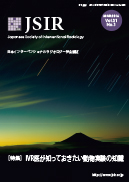Volume 31, Issue 1
Displaying 1-11 of 11 articles from this issue
- |<
- <
- 1
- >
- >|
State of the Art
Knowledge of Animal Experiments for Interventional Radiologists
-
2016 Volume 31 Issue 1 Pages 5-12
Published: 2016
Released on J-STAGE: September 07, 2016
Download PDF (964K) -
2016 Volume 31 Issue 1 Pages 13-17
Published: 2016
Released on J-STAGE: September 07, 2016
Download PDF (1359K) -
2016 Volume 31 Issue 1 Pages 18-25
Published: 2016
Released on J-STAGE: September 07, 2016
Download PDF (3201K) -
2016 Volume 31 Issue 1 Pages 26-33
Published: 2016
Released on J-STAGE: September 07, 2016
Download PDF (2587K) -
2016 Volume 31 Issue 1 Pages 34-41
Published: 2016
Released on J-STAGE: September 07, 2016
Download PDF (1373K)
-
2016 Volume 31 Issue 1 Pages 42-49
Published: 2016
Released on J-STAGE: September 07, 2016
Download PDF (2984K) -
2016 Volume 31 Issue 1 Pages 50-55
Published: 2016
Released on J-STAGE: September 07, 2016
Download PDF (1688K)
-
2016 Volume 31 Issue 1 Pages 56-61
Published: 2016
Released on J-STAGE: September 07, 2016
Download PDF (1627K) -
2016 Volume 31 Issue 1 Pages 62-68
Published: 2016
Released on J-STAGE: September 07, 2016
Download PDF (2448K) -
2016 Volume 31 Issue 1 Pages 69-75
Published: 2016
Released on J-STAGE: September 07, 2016
Download PDF (1387K) -
2016 Volume 31 Issue 1 Pages 76-81
Published: 2016
Released on J-STAGE: September 07, 2016
Download PDF (1304K)
- |<
- <
- 1
- >
- >|
